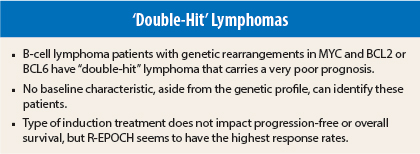"Double-hit” lymphomas remain challenging tumors, and the best means of treatment remains somewhat elusive, according to studies presented at the 2013 American Society of Hematology (ASH) Annual Meeting in New Orleans, and experts who commented on these findings.
“We still don’t have a standard of care, much less a home run,” said Myron S. Czuczman, MD, of Roswell Park Cancer Institute in Buffalo, New York, who spoke on the topic at the 2014 Highlights of ASH in North America meeting in Miami.
The ASCO Post also spoke with Daniel J. Landsburg, MD, a fellow in the Division of Hematology/Oncology at the Hospital of the University of Pennsylvania, Philadelphia, who noted, “Double-hit lymphoma is a very interesting disease that is difficult to treat effectively. I think that targeted therapies hold promise, but we are not there yet.”
Double-hit lymphomas are high-grade B-cell lymphomas characterized by dual chromosomal rearrangements, specifically of MYC and either BCL2 or, less commonly, BCL6. “It’s the worst of both worlds,” Dr. Czuczman said. “You have Bcl2 protein expression, which renders cells antiapoptotic and more difficult to kill, and a MYC rearrangement that makes cells more proliferative. You can kill MYC-positive cells, but if you add resistance to chemotherapy you get the double hit.”
Outcomes are typically poor with standard immunochemotherapy regimens, ie, R-CHOP (rituximab [Rituxan] plus cyclophosphamide, doxorubicin, vincristine, prednisone), as compared to patients with similar histologies lacking the dual genetic anomalies. This often prompts the use of more intensive treatments, Dr. Landsburg added.
Impact of Induction and Consolidation Transplant
At the ASH highlights meeting, Dr. Czuczman described a 15-center study by Mitul Gandhi, MD, of Robert H. Lurie Comprehensive Cancer Center, Feinberg School of Medicine, Northwestern University, Chicago, and colleagues. These investigators retrospectively evaluated the use of intensive induction regimens, with or without consolidative stem cell transplantation, in patients with double-hit lymphoma.1
Patients were treated with R-CHOP or one of the following intensified regimens: R-hyperCVAD (rituximab plus cyclophosphamide, vincristine, doxorubicin, dexamethasone, cytarabine, methotrexate [cycle A], alternating with methotrexate, leucovorin, cytarabine [cycle B]); R-EPOCH (rituximab plus etoposide, prednisone, vincristine, cyclohosphamide, doxorubicin); R-CODOX-M/IVAC (rituximab plus cyclophosphamide, vincristine, doxorubicin, methotrexate, ifosfamide, etoposide, cytarabine); or R-ICE (rituximab plus ifosfamide, carboplatin, etoposide).
The 106 patients primarily had rearrangements of MYC and BCL2. The most common histology was diffuse large B-cell lymphoma (53%), followed by B-cell lymphoma–unclassified (42%), and Burkitt-like lymphoma (5%). Fourteen patients (13%) were consolidated with transplant after intensive induction. Three additional patients underwent transplant in partial remission after R-CHOP.
“We see that the results without transplant are pretty dismal,” Dr. Czuczman said. “R-EPOCH is a little better, but there is no significant difference in overall survival.” Median progression-free survival and overall survival for the entire cohort was 16.2 months and 34.8 months, respectively, at a median follow-up time of 23 months.
While the type of induction chemoimmunotherapy did not improve progression-free or overall survival in double-hit lymphoma patients, the alternative regimens were associated with higher response rates than R-CHOP, especially R-EPOCH where complete responses were almost 80%, compared to approximately 45% with R-CHOP and 60% with the other regimens. With R-EPOCH, as well, only about 10% of patients had progressive disease as their best response.
“The study confirmed that double-hit lymphoma is associated with a poor prognosis, although a subset of patients can achieve a durable complete response. R-EPOCH was associated with improved rates of complete response and decreased rates of primary refractory disease. The study also showed that stem cell transplant does not clearly improve overall survival compared to observation alone, in patients who achieve a complete response,” he said at the ASH highlights meeting. While transplant can produce better outcomes, he added, early relapse is common.
Can Baseline Characteristics Be Helpful?
At the ASH Annual Meeting, Dr. Landsburg presented an analysis of 53 patients with B-cell lymphoma who underwent diagnostic fluorescence in situ hybridization (FISH).2 The study evaluated whether double-hit status can be predicted by clinicopathologic features, which theoretically could be useful in streamlining expensive tests, and it documented the impact of double-hit status on survival. Double-hit lymphoma was identified in 32% of patients, while a sole MYC gene rearrangement was found in 17%.
“No factor, including age, [lactate dehydrogenase], stage, [International Prognostic Index], or histology, was predictive of double-hit status,” Dr. Landsburg reported.
Patients with double-hit lymphoma were treated with R-hyperCVAD (41%), R-CHOP (41%), and other regimens (18%) at the discretion of the physician. Compared to patients lacking double hits, these patients were significantly less likely to achieve a complete response (41% vs 81%, P = .002) and had a significantly shorter median overall survival (8.2 vs 56.8 months, P < .001).
In the multivariate regression analysis for overall survival, only double-hit–positive status was a significant predictive factor, carrying a hazard ratio (HR) of 7.3 (P = .013). In the univariate analysis, MYC rearrangement was significant (HR = 5.0, P = .004), along with double-hit status (HR = 9.2, P < .001), he reported. A sole MYC rearrangement did not appear to carry a worse prognosis than normal MYC status, as median overall survival was 50.8 months in this group and was not reached in patients lacking a MYC rearrangement (P = .33).
“Double-hit status cannot be inferred by baseline disease- or patient-related characteristics and is most predictive of overall survival in this cohort of B-cell lymphoma patients,” he concluded. “These findings support the practice of routine FISH for gene rearrangements in order to increase the identification of double-hit patients who may benefit from risk-adapted therapy.”
At the University of Pennsylvania, most patients receive R-hyperCVAD. “Relapses are very tough to salvage, so if a patient is young and healthy, we give intensive chemotherapy up front and hope to get them into remission,” Dr. Landsburg said. He noted that, unlike R-EPOCH, the “B” cycle of R-hyperCVAD provides penetration into the central nervous system, but R-EPOCH is easier to give. “We feel better about giving hyperCVAD, but it is a difficult regimen for patients to tolerate, and you need to monitor closely for toxicity,” he added.
The investigators plan to validate their findings in a larger unselected cohort of diffuse large B-cell lymphoma patients, the group most impacted by double hits. Both experts agreed on the urgent need for novel approaches to overcome the unfavorable biology of this malignancy. They felt that the Bcl2 inhibitor ABT-199 is a promising compound, as it might be able to downregulate Bcl2 and resensitize patients to chemotherapy. ■
Disclosure: Drs. Czuczman and Landsburg reported no potential conflicts of interest.
References
1. Gandhi M, Petrich AD, Cassaday RD, et al: Impact of induction regimen and consolidative stem cell transplantation in patients with double hit lymphoma: A large multicenter retrospective analysis. 2013 ASH Annual Meeting. Abstract 640. Presented December 9, 2013.
2. Landsburg D, Nasta D, Svoboda J, et al: “Double-hit” cytogenetic status is not predicted by baseline clinicopathologic characteristics and is highly associated with overall survival in B cell lymphoma patients. 2013 ASH Annual Meeting. Abstract 4338. Presented December 9, 2013.




